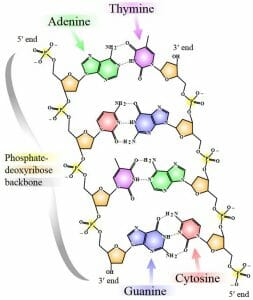Nucleotide Definition
Nucleotides are organic molecules that are the building blocks of DNA and RNA. They also have functions related to cell signaling, metabolism, and enzyme reactions. Nucleotides are made up of three parts: a phosphate group, a 5-carbon sugar, and a nitrogenous base. The four nitrogenous bases in DNA are adenine, cytosine, guanine, and thymine. RNA contains uracil instead of thymine. Nucleotides make up the DNA and RNA of all living things.
Parts of the Nucleotide
The figure below shows the three parts of the nucleotide. From left to right, each nucleotide is made up of a phosphate group, a 5-carbon sugar, and a nitrogenous base (the one shown here is adenine).
In DNA, the 5-carbon sugar is deoxyribose, while in RNA, the 5-carbon sugar is ribose. This gives DNA and RNA their names; the full name of DNA is deoxyribonucleic acid, and RNA is ribonucleic acid.
DNA and RNA contain all the genetic information necessary for cells to function. In DNA and RNA, many nucleotides are bonded together to form long strands in a structure called a double helix. The phosphate group and the 5-carbon sugar compose the backbone of the double helix, while the nitrogenous bases are located in the middle and are bonded to each other.
This figure shows the chemical structure of DNA. Note how the phosphates and sugars are bonded to form a backbone, and the nitrogenous bases are also bonded to each other in the middle of the double helix:
Types of Nitrogenous Bases in Nucleotides
The five types of nitrogenous bases that are found in nucleotides are called adenine, cytosine, guanine, thymine, and uracil. They are often abbreviated to A, C, G, T, and U.
Adenine
Adenine is a purine, which is one of two families of nitrogenous bases. Purines have a double-ringed structure. In DNA, adenine bonds with thymine. In RNA, adenine bonds with uracil.
Cytosine
The other family of nitrogenous bases is pyrimidines. Cytosine is a pyrimidine; it has only one ring in its structure. Cytosine bonds with guanine in both DNA and RNA.
Guanine
Like adenine, guanine is a purine; it has a double ring. It bonds with cytosine in DNA and RNA.
Thymine
Like cytosine, thymine is a pyrimidine and has one ring. It bonds with adenine in DNA. Thymine is not found in RNA.
Uracil
Uracil is also a pyrimidine. It bonds with adenine in RNA; it is not found in DNA.
More on Nitrogenous Bases
These paired nitrogenous bases make up the middle of the double helix structure. A purine always binds with a pyrimidine, but more specifically, each base bonds with its complementary base: A with T (or U, in RNA), C with G, and vice versa. When the nitrogenous bases of two nucleotides are bonded, they are referred to as base pairs. The bases are connected via hydrogen bonds. Hydrogen bonds can easily detach so that the DNA can “unzip” during the replication process.
Sometimes when DNA is replicated, the wrong nitrogenous base is inserted into the copy of the DNA. There are mechanisms in place to correct these errors, but some go through unnoticed with the result that the DNA does not have a proper base pairing at the location. These are called point mutations and can affect a gene’s functioning. Most point mutations are harmless, but if they occur in sperm or egg cells, they can be passed on to offspring. Sickle cell anemia is an example of a disorder that is caused by a single point mutation in the gene that creates hemoglobin, which is the part of red blood cells that carries oxygen to the rest of the body.
Functions of Nucleotides
Besides being the basic unit of genetic material for all living things, nucleotides have other functions as well. Nucleotides are found in other molecules such as adenosine triphosphate (ATP), which is the main energy molecule of the cell. They are also found in coenzymes like NAD and NADP, which come from ADP; these molecules are used in many chemical reactions that play roles in metabolism. Another molecule that contains nucleotides is cyclic AMP (cAMP), a messenger molecule that is important in many processes including the regulation of metabolism and transporting chemical signals to cells. Nucleotides not only make up the building blocks of life, but also form many different molecules that function to make life possible.
Related Biology Terms
- Deoxyribonucleic acid (DNA) – a molecule that contains all the genetic instructions that allow an organism to function.
- Ribonucleic acid (RNA) – a molecule similar to DNA that plays a role in many activities such as protein synthesis, gene expression, and aiding chemical reactions.
- Nitrogenous base – a nitrogen-containing molecule that is one of the components of a nucleotide. The nitrogenous bases in DNA and RNA are adenine, cytosine, guanine, thymine, and uracil.
- Purine – one of the two families of nitrogenous base pair molecules. Purines have a double-ring structure; the other family is the pyrimidines, which have a single ring.
Test Your Knowledge of Nucleotides
1. Which is NOT one of the parts of a nucleotide?
A. 5-carbon sugar
B. Phosphate group
C. Phospholipid
D. Nitrogenous base
2. Which is a correct pairing?
A. Adenine–Guanine
B. Cytosine–Guanine
C. Thymine–Uracil
D. Uracil–Cytosine
3. Which nitrogenous base is not found in DNA?
A. Uracil
B. Thymine
C. Adenine
D. Guanine
Nucleotide







No comments:
Post a Comment